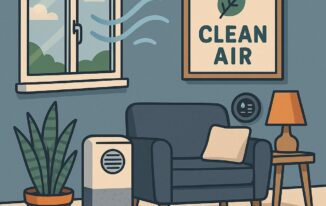
Key Takeaways
- Regular maintenance and simple habits can significantly improve the air you breathe indoors.
- Choosing the right filtration systems can significantly reduce common pollutants.
- Natural solutions like houseplants and ventilation are vital for clean indoor air.
- Awareness of sources of indoor pollution helps you make informed decisions for a healthier living space.
- There are practical steps everyone can follow, regardless of home size or budget.
Table of Contents
- Why Indoor Air Quality Matters
- Familiar Sources of Indoor Pollutants
- Easy Habits for Better Air
- Ventilation and Filtration Tips
- The Role of Houseplants in Cleaner Air
- Technology to Boost Air Quality
Why Indoor Air Quality Matters
The concept of air quality is often discussed in terms of outdoor pollution, yet the air inside homes can be even more hazardous. According to the Environmental Protection Agency, levels of indoor air pollutants are often two to five times higher than those found outdoors, and at times much higher. This fact carries more weight when you consider that most people spend as much as 90% of their time indoors—sleeping, working from home, or relaxing during downtime. The accumulation of hidden pollutants such as dust mites, pet dander, chemical fumes from household cleaners, and mold spores poses a risk to everyone, especially to sensitive groups such as children, older people, or those with underlying respiratory issues.
Familiar Sources of Indoor Pollutants
Hidden threats to clean air are present in almost every home. Many household products—such as air fresheners, fabric softeners, and disinfectants—release volatile organic compounds, or VOCs, that linger long after use. Off-gassing from new furniture, carpets, or freshly painted surfaces can add to the load. Cooking oils, tobacco smoke, and even burning scented candles produce fine particulates that circulate quickly, settling on surfaces and catching up in HVAC systems. Pets, while beloved, release dander that can trigger allergies and accumulate in hard-to-reach places. An easy first step toward creating a healthier indoor environment is seeking support from an experienced HVAC contractor who can inspect your current systems and point out actionable improvements specific to your living space.
Easy Habits for Better Air
Many improvements in indoor air quality start with consistent, straightforward routines, separate from the services offered by an air conditioning repair service. Regularly vacuuming floors and upholstery with a HEPA filter-equipped vacuum can capture dust, pet hair, pollen, and even tiny mold spores that trigger allergies, a task unrelated to an air conditioning repair service. Pair vacuuming with damp mopping to lift debris that vacuums might blow back into the air for optimal results, an effort that complements but doesn’t replace the need for an air conditioning repair service when issues arise. Dust surfaces using a microfiber cloth, which attracts dust without redistributing it around the room, another helpful practice independent of an air conditioning repair service.
Ventilation and Filtration Tips
Adequate ventilation and robust filtration can transform air quality. Cross-ventilating rooms by opening windows on opposite walls creates airflow that sweeps out indoor toxins. For days when outdoor air quality is poor or pollen counts are high, mechanical solutions become even more vital. Ensure that the ceiling or oscillating fans are clean and that air vents aren’t blocked by curtains or furniture to maximize your HVAC system’s reach. Investing in a high-quality, modern air purifier can make a measurable difference in homes with pets, allergy sufferers, or spaces exposed to cigarette smoke.
The Role of Houseplants in Cleaner Air
Houseplants are more than just decorative—they offer subtle but valuable benefits to air quality. Research, including notable studies by NASA, suggests that varieties such as spider, snake, and peace lilies have demonstrated the ability to reduce trace pollutants like formaldehyde, benzene, and trichloroethylene. While a single plant won’t purify a whole room, spreading several throughout the house contributes to higher local humidity and a fresher feel, especially in dry environments.
Technology to Boost Air Quality
New home technologies put monitoring and improvement in the palm of your hand. Smart indoor air quality monitors detect real-time changes in fine particulates, carbon dioxide, humidity, temperature, and volatile organic compounds. Many sync with smart home systems to send automatic alerts, or even trigger purifiers and exhaust fans as needed if air quality dips below healthy thresholds. These sensors empower you to identify trends—such as a rise in pollutants after cooking, cleaning, or opening windows during allergy season—and take action accordingly.
Smart thermostats also contribute by managing airflow and regulating humidity, ensuring the environment stays consistent throughout the year. These modern systems can save on utility bills by running only when needed and provide valuable data for keeping your air and home healthy. These technological upgrades can be a game-changer for homes with family members with allergies or sensitive lungs.


